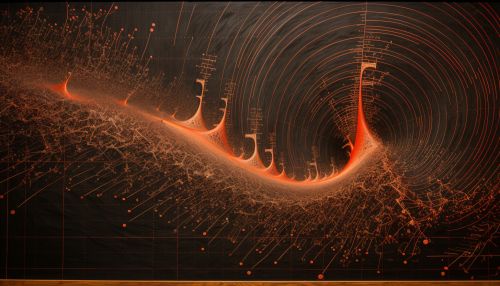Stress–energy tensor
Introduction
The Stress–energy tensor is a fundamental concept in the field of Physics, particularly in the study of general relativity and quantum field theory. It is a second-order tensor that describes the density and flux of energy and momentum in spacetime, generalizing the stress tensor of Newtonian physics. It is an attribute of matter, radiation, and non-gravitational force fields. The stress–energy tensor is the source of the gravitational field in the Einstein field equations of general relativity, just as mass density is the source of such a field in Newtonian gravity.
Mathematical Representation
The stress–energy tensor is represented mathematically as a symmetric rank-2 tensor. In four-dimensional spacetime, the stress–energy tensor is a 4×4 matrix, usually written in the form:
- T^μν = (ρ + p)u^μu^ν - pg^μν
where ρ is the energy density, p is the pressure, u^μ is the 4-velocity, and g^μν is the metric tensor. The indices μ and ν each range over the four spacetime dimensions. The stress–energy tensor is symmetric, so T^μν = T^νμ.
Components of the Stress–Energy Tensor
The stress–energy tensor consists of 10 independent components, due to its symmetry. These components can be categorized into energy density, momentum density, and stress:
- Energy density (T^00): This is the energy density as measured by an observer moving with the fluid. It is the source of the gravitational field in the time-time component of the Einstein field equations.
- Momentum density (T^0i): These are the flux of i-th component of momentum across a surface of constant time, as measured by an observer moving with the fluid. They are the source of the gravitational field in the time-space components of the Einstein field equations.
- Stress (T^ij): These are the flux of i-th component of momentum across a surface of constant j-th spatial coordinate. They are the source of the gravitational field in the space-space components of the Einstein field equations.
Conservation Laws
The stress–energy tensor obeys certain conservation laws, which are expressed mathematically by the covariant divergence of the stress–energy tensor being zero:
- ∇_μ T^μν = 0
This equation expresses the conservation of energy and momentum. In a certain sense, it is the relativistic generalization of the continuity equation from fluid dynamics.
Stress–Energy Tensor in General Relativity
In the context of general relativity, the stress–energy tensor plays a crucial role in describing the curvature of spacetime. The Einstein field equations, which describe the dynamics of the gravitational field, can be written as:
- G^μν = 8πT^μν
where G^μν is the Einstein tensor, which is a function of the metric tensor and its first and second derivatives. The stress–energy tensor T^μν on the right-hand side of this equation describes the distribution of matter and energy in spacetime.
Stress–Energy Tensor in Quantum Field Theory
In quantum field theory, the stress–energy tensor is a quantum operator that corresponds to the classical stress–energy tensor. It plays a crucial role in the theory of quantum gravity, where it is the source of the gravitational field in the same way as in classical general relativity.


